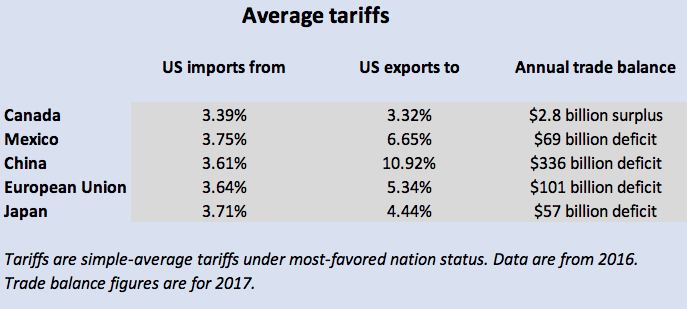Why Trump’s trade war is unnecessary
President Trump has launched an escalating series of trade battles on the premise that foreign trading partners are ripping off the United States.
So are they?
We examined average tariffs for the United States and 5 of its biggest trading partners, and the answer, for the most part, is no. Trump says he wants “fairer” trade, and his tactics now include new tariffs on steel and aluminum imports, along with a raft of other imports from China. He has threatened additional tariffs on a much bigger basket of imports. (Here’s our ongoing tariff scorecard.)
Canada, Europe and China have retaliated with tariffs of their own on U.S. exports to those countries. And the United States and several trading partners have filed complaints with the World Trade Organization, which handles trade disputes. There’s no sign of any side backing down.
Trump kicked off his trade wars even though the majority of America’s big trading partners have relatively low barriers to US exports. Yahoo Finance gathered data on average tariffs among the United States and five key trade partners, with help from researcher Euijin Jung of the Peterson Institute for International Economics. These numbers are for 2016, the most recent year for which full data is available.

As the numbers show, the United States is a low-tariff nation with minimal barriers on most imports. But U.S. exporters face relatively low barriers, as well. “For the most part, we have very free trade with Europe and Canada, for most products, most of the time,” says Harvard economist Jason Furman, who chaired the Council of Economic Advisers under President Obama. “On the ones where we don’t have free trade, we have some things we do unfairly to them and they have some things they do unfairly to us.”
Trump has complained about Canadian tariffs on imported butter and other dairy products, which are nearly 300%. But many U.S. exports to Canada face no tariffs, and the average tariff Canada imposes is nearly as low as the U.S. tariff on Canadian imports.
Japan and Europe levy slightly higher tariffs on US exports, but the gap is still less than 2 percentage points. And all nations have some protections in place, usually for political reasons. Trump has griped about Europe’s 10% tariff on cars exported from the United States, since the US tariff on imported European cars is just 2.5%. But the United States also has a 25% tariff on imported pickup trucks and SUVs, which keeps many foreign-made models out of the U.S. market.
Mexico’s average tariff on U.S. exports to the country is roughly 3 percentage points higher than the U.S. tariff on Mexican imports. The gap is largest with China, which imposes a tariff on U.S. exports that’s more than 7 points higher than the U.S. tariff on Chinese imports.
Mexico and China are somewhat different from Canada and Europe. Both countries are considered developing nations, rather than advanced economies like the United States, which traditionally allows for higher tariffs, to help home-grown industries get off the ground. Mexico, along with Canada and the United States, belongs to the North American Free Trade Agreement, which Trump is trying to revamp. Updating NAFTA is a reasonable thing to do, because much has changed since it went into effect in 1993. But trade with Mexico isn’t a “bad deal” for the United States, as Trump claims. It actually lowers costs for American producers and consumers and lets companies produce more efficiently.
There’s a stronger case for addressing trade abuses by China, which has grown from a backwater economy into the world’s second-largest market. China clearly does coerce foreign firms into turning over technology as a price of entry into its booming market. The government subsidizes giant firms that sell commodities around the world at below-market prices, undercutting competitors that play by the rules. It arbitrarily enforces laws in ways that favor domestic companies and harm foreign competition.
Trump’s main fixation appears to be the U.S. trade deficit with China, Mexico and Europe, and it’s clear the United States imports considerably more than it exports. But that’s because Americans consume more than we produce at home, and spend most of our money instead of saving it. The main way nations reduce their trade deficits is to save more and spend less, which is not one of Trump’s proposals.
Trump prefers tariff wars, even though they raise costs on all sides and harm American consumers, who end up paying more. A better approach might be for the United States to team up with allies and push for WTO reforms that would put stricter rules on China’s behavior. It could also form trade alliances meant to counter China’s heft in Asia. Trump, however, has rejected both approaches.
Overlooked amid Trump’s trade tirades is the fact that low U.S. tariffs mean cheap products for American shoppers. If Trump persists in his tariff-raising, which is certainly plausible, prices will rise in ways consumers will start to notice. Tariffs are ultimately a tax on consumers, which is an odd thing for an elected official to favor.
Confidential tip line: [email protected]. Click here to get Rick’s stories by email.
Read more:
Rick Newman is the author of four books, including “Rebounders: How Winners Pivot from Setback to Success.” Follow him on Twitter: @rickjnewman
Follow Yahoo Finance on Facebook, Twitter, Instagram, and LinkedIn
